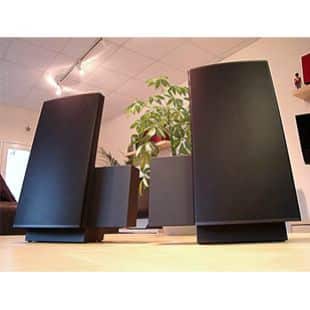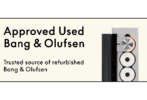
BeoLab 2500
BeoLab 2500 are active loudspeakers designed to match the BeoSound Ouverture and the BeoSound 3000. With their built-in amplifiers, they sound as if they’re three times their size. Hang them on the wall or place them on bookshelves. They match both the Beocenter Ouverture and 3000 (previous to this they were used with both the […]
Overview
BeoLab 2500 are active loudspeakers designed to match the BeoSound Ouverture and the BeoSound 3000. With their built-in amplifiers, they sound as if they’re three times their size. Hang them on the wall or place them on bookshelves.
They match both the Beocenter Ouverture and 3000 (previous to this they were used with both the BeoSound 2300 and 2500 music systems) with perspective and clarity, despite their modest dimensions. The explanation of the wide sound lies in the built-in amplifiers in each cabinet: one for bass and one for treble, so that they never have to compete for the same amplifier.
Features:
BeoLab 2500 are active loudspeakers with 2 built-in power amplifier modules to combine with the current (2002) BeoSound 3000 and BeoSound Ouverture. As speakers for the BeoSound 2300 and 2500 music systems, they were available in Blue Lapis, Black Granite, Red Garnet, Green Malachite, Yellow Dolomite and Silver Galena. However, new metal frets were introduced at the end of 2001. From the previous replaceable cloth fronts, they are now manufactured in pearlescent aluminium (see below). These new perforated metal frets presently come in 5 different colours – natural aluminium, black, blue, green and russet to match those of BeoSound 1.
“When it comes to sound reproduction we believe there’s only one relevant parameter: How close can we come to the originally recorded sound. We feel an obligation not to disturb the intentions of the artist by adding unnatural elements to the acoustic image. Therefore all Bang & Olufsen loudspeakers share the same goal. They differ in size and shape and in terms of sound pressure level. But they are all developed to reproduce the natural, unaltered sound as closely as possible ” – Bang & Olufsen catalogue 2001 – 2002
Adaptive Bass Linearisation
Adaptive Bass Linearisation (ABL) is a process patented by B&O and is incorporated in BeoLab loudspeakers. The idea is to use the surplus capacity in amplifiers and driver units, arising by normal listening levels, for a bass extension – a sound reproduction with more bass, than the loudspeaker otherwise would be able to produce.
The function is adaptive. This means that the loudspeaker adapts to the signal it receives. Loudspeaker drivers are therefore fully exploited, without suffering mechanical or electronic abuse, and the built in amplifiers are not subjected to signals would otherwise create an overload situation.
ABL gives stunning bass reproduction considering the size of the loudspeaker in which it is incorporated, under normal listening levels.
Mounting Options
BeoLab2500 were originally mounted to the HiFi with wall bracket 2087 or physically separated and mounted onto furniture as a bookshelf option.
Product Details
Software
No software information available.
Product Specification
Maximum Sound Pressure Level (stereo, pair) 98 dB
Power amplifier modules 2 units, Class AB
Long-term maximum output power per module* 65 watts
Effective Frequency range* 55 - 20,000 Hz
Cabinet principle Bass Reflex
Magnetic shielded No
Woofer 11cm
Tweeter 2.5 cm
Net volume 2.8 litre
(* According to IEC 268-3 and 268-5) Dimensions W x H x D/Weight 26 x 36 x 13cm (12cm with front cloth 6036) / 6kg
Cabinet finish: black
Power consumption Typical 10 W/stand-by < 2 W
Mains 6201 EU, GB 230V
6203 USA-CDN 120V
6204 JAP 100V
6205 AUS 240V
Connections: Power Link: 2
Accessories: Front cloth 6036 Black, Blue, Green, Silver, Red, Yellow
Front cover 6039 Light Blue, Silver, Black, Russet, Violet
Downloads
Type | Language | Type | |
Setup Guide | Multi | BeoLab 2500 Setup Guide | |
Setup Guide | Port | BeoLab 2500 Setup Guide | |
Setup Guide | GR | BeoLab 2500 Setup Guide | |
Setup Guide | Hebr | BeoLab 2500 Setup Guide |
Photo Gallery
No gallery images.
Frequently Asked Questions
No FAQs available.






